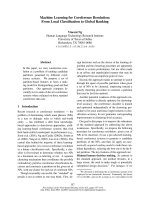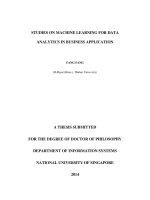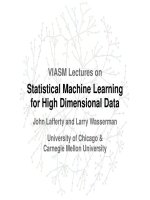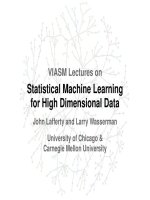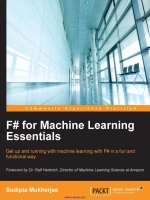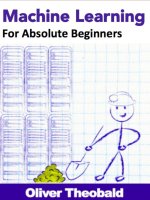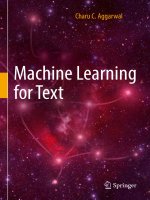Machine learning for designers (2)
Bạn đang xem bản rút gọn của tài liệu. Xem và tải ngay bản đầy đủ của tài liệu tại đây (6.84 MB, 117 trang )
Design
Machine Learning for Designers
Patrick Hebron
Machine Learning for Designers
by Patrick Hebron
Copyright © 2016 O’Reilly Media, Inc. All rights reserved.
Printed in the United States of America.
Published by O’Reilly Media, Inc., 1005 Gravenstein Highway North,
Sebastopol, CA 95472.
O’Reilly books may be purchased for educational, business, or sales
promotional use. Online editions are also available for most titles
(). For more information, contact our
corporate/institutional sales department: 800-998-9938 or
Editor: Angela Rufino
Production Editor: Shiny Kalapurakkel
Copyeditor: Dianne Russell, Octal Publishing, Inc.
Proofreader: Molly Ives Brower
Interior Designer: David Futato
Cover Designer: Randy Comer
Illustrator: Rebecca Panzer
June 2016: First Edition
Revision History for the First Edition
2016-06-09: First Release
The O’Reilly logo is a registered trademark of O’Reilly Media, Inc. Machine
Learning for Designers, the cover image, and related trade dress are
trademarks of O’Reilly Media, Inc.
While the publisher and the author have used good faith efforts to ensure that
the information and instructions contained in this work are accurate, the
publisher and the author disclaim all responsibility for errors or omissions,
including without limitation responsibility for damages resulting from the use
of or reliance on this work. Use of the information and instructions contained
in this work is at your own risk. If any code samples or other technology this
work contains or describes is subject to open source licenses or the
intellectual property rights of others, it is your responsibility to ensure that
your use thereof complies with such licenses and/or rights.
978-1-491-95620-5
[LSI]
Machine Learning for Designers
Introduction
Since the dawn of computing, we have dreamed of (and had nightmares
about) machines that can think and speak like us. But the computers we’ve
interacted with over the past few decades are a far cry from HAL 9000 or
Samantha from Her. Nevertheless, machine learning is in the midst of a
renaissance that will transform countless industries and provide designers
with a wide assortment of new tools for better engaging with and
understanding users. These technologies will give rise to new design
challenges and require new ways of thinking about the design of user
interfaces and interactions.
To take full advantage of these systems’ vast technical capabilities, designers
will need to forge even deeper collaborative relationships with programmers.
As these complex technologies make their way from research prototypes to
user-facing products, programmers will also rely upon designers to discover
engaging applications for these systems.
In the text that follows, we will explore some of the technical properties and
constraints of machine learning systems as well as their implications for userfacing designs. We will look at how designers can develop interaction
paradigms and a design vocabulary around these technologies and consider
how designers can begin to incorporate the power of machine learning into
their work.
Why Design for Machine Learning is Different
A Different Kind of Logic
In our everyday communication, we generally use what logicians call fuzzy
logic. This form of logic relates to approximate rather than exact reasoning.
For example, we might identify an object as being “very small,” “slightly
red,” or “pretty nearby.” These statements do not hold an exact meaning and
are often context-dependent. When we say that a car is small, this implies a
very different scale than when we say that a planet is small. Describing an
object in these terms requires an auxiliary knowledge of the range of possible
values that exists within a specific domain of meaning. If we had only seen
one car ever, we would not be able to distinguish a small car from a large
one. Even if we had seen a handful of cars, we could not say with great
assurance that we knew the full range of possible car sizes. With sufficient
experience, we could never be completely sure that we had seen the smallest
and largest of all cars, but we could feel relatively certain that we had a good
approximation of the range. Since the people around us will tend to have had
relatively similar experiences of cars, we can meaningfully discuss them with
one another in fuzzy terms.
Computers, however, have not traditionally had access to this sort of
auxiliary knowledge. Instead, they have lived a life of experiential
deprivation. As such, traditional computing platforms have been designed to
operate on logical expressions that can be evaluated without the knowledge
of any outside factor beyond those expressly provided to them. Though fuzzy
logical expressions can be employed by traditional platforms through the
programmer’s or user’s explicit delineation of a fuzzy term such as “very
small,” these systems have generally been designed to deal with boolean
logic (also called “binary logic”), in which every expression must ultimately
evaluate to either true or false. One rationale for this approach, as we will
discuss further in the next section, is that boolean logic allows a computer
program’s behavior to be defined as a finite set of concrete states, making it
easier to build and test systems that will behave in a predictable manner and
conform precisely to their programmer’s intentions.
Machine learning changes all this by providing mechanisms for imparting
experiential knowledge upon computing systems. These technologies enable
machines to deal with fuzzier and more complex or “human” concepts, but
also bring an assortment of design challenges related to the sometimes
problematic nature of working with imprecise terminology and unpredictable
behavior.
A Different Kind of Development
In traditional programming environments, developers use boolean logic to
explicitly describe each of a program’s possible states and the exact
conditions under which the user will be able to transition between them. This
is analogous to a “choose-your-own-adventure” book, which contains
instructions like, “if you want the prince to fight the dragon, turn to page 32.”
In code, a conditional expression (also called an if-statement) is employed to
move the user to a particular portion of the code if some pre defined set of
conditions is met.
In pseudocode, a conditional expression might look like this:
if ( mouse button is pressed and mouse is over the 'Login'
button ),
then show the 'Welcome' screen
Since a program comprises a finite number of states and transitions, which
can be explicitly enumerated and inspected, the program’s overall behavior
should be predictable, repeatable, and testable. This is not to say, of course,
that traditional programmatic logic cannot contain hard-to-foresee “edgecases,” which lead to undefined or undesirable behavior under some specific
set of conditions that have not been addressed by the programmer. Yet,
regardless of the difficulty of identifying these problematic edge-cases in a
complex piece of software, it is at least conceptually possible to methodically
probe every possible path within the “choose-your-own-adventure” and
prevent the user from accessing an undesirable state by altering or appending
the program’s explicitly defined logic.
The behavior of machine learning systems, on the other hand, is not defined
through this kind of explicit programming process. Instead of using an
explicit set of rules to describe a program’s possible behaviors, a machine
learning system looks for patterns within a set of example behaviors in order
to produce an approximate representation of the rules themselves.
This process is somewhat like our own mental processes for learning about
the world around us. Long before we encounter any formal description of the
“laws” of physics, we learn to operate within them by observing the
outcomes of our interactions with the physical world. A child may have no
awareness of Newton’s equations, but through repeated observation and
experimentation, the child will come to recognize patterns in the relationships
between the physical properties and behaviors of objects.
While this approach offers an extremely effective mechanism for learning to
operate on complex systems, it does not yield a concrete or explicit set of
rules governing that system. In the context of human intelligence, we often
refer to this as “intuition,” or the ability to operate on complex systems
without being able to formally articulate the procedure by which we achieved
some desired outcome. Informed by experience, we come up with a set of
approximate or provisional rules known as heuristics (or “rules of thumb”)
and operate on that basis.
In a machine learning system, these implicitly defined rules look nothing like
the explicitly defined logical expressions of a traditional programming
language. Instead, they are comprised of distributed representations that
implicitly describe the probabilistic connections between the set of
interrelated components of a complex system.
Machine learning often requires a very large number of examples to produce
a strong intuition for the behaviors of a complex system.
In a sense, this requirement is related to the problem of edge-cases, which
present a different set of challenges in the context of machine learning. Just
as it is hard to imagine every possible outcome of a set of rules, it is,
conversely, difficult to extrapolate every possible rule from a set of example
outcomes. To extrapolate a good approximation of the rules, the learner must
observe many variations of their application. The learner must be exposed to
the more extreme or unlikely behaviors of a system as well as the most likely
ones. Or, as the educational philosopher Patricia Carini said, “To let meaning
occur requires time and the possibility for the rich and varied relationships
among things to become evident.”1
While intuitive learners may be slower at rote procedural tasks such as those
performed by a calculator, they are able to perform much more complex tasks
that do not lend themselves to exact procedures. Nevertheless, even with an
immense amount of training, these intuitive approaches sometimes fail us.
We may, for instance, find ourselves mistakenly identifying a human face in
a cloud or a grilled cheese sandwich.
A Different Kind of Precision
A key principle in the design of conventional programming languages is that
each feature should work in a predictable, repeatable manner provided that
the feature is being used correctly by the programmer. No matter how many
times we perform an arithmetic operation such as “2 + 2,” we should always
get the same answer. If this is ever untrue, then a bug exists in the language
or tool we are using. Though it is not inconceivable for a programming
language to contain a bug, it is relatively rare and would almost never pertain
to an operation as commonly used as an arithmetic operator. To be extra
certain that conventional code will operate as expected, most large-scale
codebases ship with a set of formal “unit tests” that can be run on the user’s
machine at installation time to ensure that the functionality of the system is
fully in line with the developer’s expectations.
So, putting rare bugs aside, conventional programming languages can be
thought of as systems that are always correct about mundane things like
concrete mathematical operations. Machine learning algorithms, on the other
hand, can be thought of as systems that are often correct about more
complicated things like identifying human faces in an image. Since a machine
learning system is designed to probabilistically approximate a set of
demonstrated behaviors, its very nature generally precludes it from behaving
in an entirely predictable and reproducible manner, even if it has been
properly trained on an extremely large number of examples. This is not to
say, of course, that a well-trained machine learning system’s behavior must
inherently be erratic to a detrimental degree. Rather, it should be understood
and considered within the design of machine-learning-enhanced systems that
their capacity for dealing with extraordinarily complex concepts and patterns
also comes with a certain degree of imprecision and unpredictability beyond
what can be expected from traditional computing platforms.
Later in the text, we will take a closer look at some design strategies for
dealing with imprecision and unpredictable behaviors in machine learning
systems.
A Different Kind of Problem
Machine learning can perform complex tasks that cannot be addressed by
conventional computing platforms. However, the process of training and
utilizing machine learning systems often comes with substantially greater
overhead than the process of developing conventional systems. So while
machine learning systems can be taught to perform simple tasks such as
arithmetic operations, as a general rule of thumb, you should only take a
machine learning approach to a given problem if no viable conventional
approach exists.
Even for tasks that are well-suited to a machine learning solution, there are
numerous considerations about which learning mechanisms to use and how to
curate the training data so that it can be most comprehensible to the learning
system.
In the sections that follow, we will look more closely at how to identify
problems that are well-suited for machine learning solutions as well as the
numerous factors that go into applying learning algorithms to specific
problems. But for the time being, we should understand machine learning to
be useful in solving problems that can be encapsulated by a set of examples,
but not easily described in formal terms.
What Is Machine Learning?
The Mental Process of Recognizing Objects
Think about your own mental process of recognizing a human face. It’s such
an innate, automatic behavior, it is difficult to think about in concrete terms.
But this difficulty is not only a product of the fact that you have performed
the task so many times. There are many other often-repeated procedures that
we could express concretely, like how to brush your teeth or scramble an egg.
Rather, it is nearly impossible to describe the process of recognizing a face
because it involves the balancing of an extremely large and complex set of
interrelated factors, and therefore defies any concrete description as a
sequence of steps or set of rules.
To begin with, there is a great deal of variation in the facial features of people
of different ethnicities, ages, and genders. Furthermore, every individual
person can be viewed from an infinite number of vantage points in countless
lighting scenarios and surrounding environments. In assessing whether the
object we are looking at is a human face, we must consider each of these
properties in relation to each other. As we change vantage points around the
face, the proportion and relative placement of the nose changes in relation to
the eyes. As the face moves closer to or further from other objects and light
sources, its coloring and regions of contrast change too.
There are infinite combinations of properties that would yield the valid
identification of a human face and an equally great number of combinations
that would not. The set of rules separating these two groups is just too
complex to describe through conditional logic. We are able to identify a face
almost automatically because our great wealth of experience in observing and
interacting with the visible world has allowed us to build up a set of
heuristics that can be used to quickly, intuitively, and somewhat imprecisely
gauge whether a particular expression of properties is in the correct balance
to form a human face.
Learning by Example
In logic, there are two main approaches to reasoning about how a set of
specific observations and a set of general rules relate to one another. In
deductive reasoning, we start with a broad theory about the rules governing a
system, distill this theory into more specific hypotheses, gather specific
observations and test them against our hypotheses in order to confirm
whether the original theory was correct. In inductive reasoning, we start with
a group of specific observations, look for patterns in those observations,
formulate tentative hypotheses, and ultimately try to produce a general theory
that encompasses our original observations. See Figure 1-1 for an illustration
of the differences between these two forms of reasoning.
Figure 1-1. Deductive reasoning versus inductive reasoning
Each of these approaches plays an important role in scientific inquiry. In
some cases, we have a general sense of the principles that govern a system,
but need to confirm that our beliefs hold true across many specific instances.
In other cases, we have made a set of observations and wish to develop a
general theory that explains them.
To a large extent, machine learning systems can be seen as tools that assist or
automate inductive reasoning processes. In a simple system that is governed
by a small number of rules, it is often quite easy to produce a general theory
from a handful of specific examples. Consider Figure 1-2 as an example of
such a system.2
Figure 1-2. A simple system
In this system, you should have no trouble uncovering the singular rule that
governs inclusion: open figures are included and closed figures are excluded.
Once discovered, you can easily apply this rule to the uncategorized figures
in the bottom row.
In Figure 1-3, you may have to look a bit harder.
Figure 1-3. A more complex system
Here, there seem to be more variables involved. You may have considered
the shape and shading of each figure before discovering that in fact this
system is also governed by a single attribute: the figure’s height. If it took
you a moment to discover the rule, it is likely because you spent time
considering attributes that seemed like they would be pertinent to the
determination but were ultimately not. This kind of “noise” exists in many
systems, making it more difficult to isolate the meaningful attributes.
Let’s now consider Figure 1-4.
Figure 1-4. An even more complex system
In this diagram, the rules have in fact gotten a bit more complicated. Here,
shaded triangles and unshaded quadrilaterals are included and all other
figures are excluded. This rule system is harder to uncover because it
involves an interdependency between two attributes of the figures. Neither
the shape nor the shading alone determines inclusion. A triangle’s inclusion
depends upon its shading and a shaded figure’s inclusion depends upon its
shape. In machine learning, this is called a linearly inseparable problem
because it is not possible to separate the included and excluded figures using
a single “line” or determining attribute. Linearly inseparable problems are
more difficult for machine learning systems to solve, and it took several
decades of research to discover robust techniques for handling them. See
Figure 1-5.
Figure 1-5. Linearly separable versus linearly inseparable problems
In general, the difficulty of an inductive reasoning problem relates to the
number of relevant and irrelevant attributes involved as well as the subtlety
and interdependency of the relevant attributes. Many real-world problems,
like recognizing a human face, involve an immense number of interrelated
attributes and a great deal of noise. For the vast majority of human history,
this kind of problem has been beyond the reach of mechanical automation.
The advent of machine learning and the ability to automate the synthesis of
general knowledge about complex systems from specific information has
deeply significant and far-reaching implications. For designers, it means
being able to understand users more holistically through their interactions
with the interfaces and experiences we build. This understanding will allow
us to better anticipate and meet users’ needs, elevate their capabilities and
extend their reach.
Mechanical Induction
To get a better sense of how machine learning algorithms actually perform
induction, let’s consider Figure 1-6.
Figure 1-6. A system equivalent to the boolean logical expression, “AND”
This system is equivalent to the boolean logical expression, “AND.” That is,
only figures that are both shaded and closed are included. Before we turn our
attention to induction, let’s first consider how we would implement this logic
in an electrical system from a deductive point of view. In other words, if we
already knew the rule governing this system, how could we implement an
electrical device that determines whether a particular figure should be
included or excluded? See Figure 1-7.
